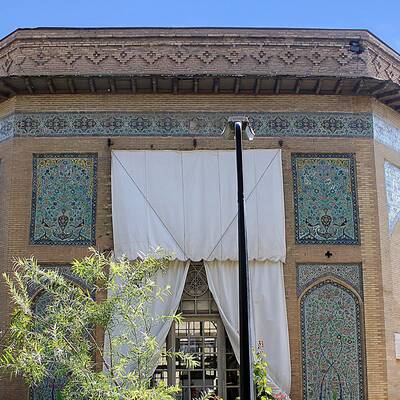
Achaemenid Museum (Persepolis Museum)
The current location of the Museum of Achaemenid or Persepolis is somehow one of the oldest buildings that was dedicated to the museum in Iran. the current place of the museum had been the main palace or harem of Xerxes I including a main hall with twelve columns, two side halls and one columned Iwan that are altogether the building of the museum.
Diggings and excavations were carried out in this part in 1311 SH by order of Ernst Herzfeld, then head of the scientific group of Persepolis, and later the palace was assimilated based upon the existing evidence in order to be both used by the group and as a place for keeping the discovered objects. The museum of Persepolis has three parts of prehistory, Achaemenid and Islamic: 1- The hall of prehistory embraces various wares and sculptures made of pottery and stone tools found in the famous hills of the prehistoric era that is a combination of art, culture, civilization with the elegance and accuracy of their makers most of which were made between the forth and the first millennium BC. There is a relief of a winged human that was copied and molded of one of the motifs of a palace in Pasargad.
Some believe this motif to be Cyrus and some others consider it to be Zolgharnain, the founder of Achaemenid empire, and others regards it a fire worshipper, however, all agree about the combination of Iran and Egypt arts in creating it. 2- Achaemenid hall that is the main hall of the palace of harem and the most significant section of the museum, keeps the objects, tools and works discovered during the excavations of Persepolis.
Most of these works are Achaemenid seals, clay tablets in cuneiform script, the cow’s eye and ear made of stone, the lion’s claw and head made of stone, flycatcher and many more. Using the Persepolis colors, pieces of the burnt curtain and the translation of Xerxes inscription that is known as the Harem Inscription are among the interesting works of this part. 3- Islamic hall includes the wares and objects that have been found during the excavations of the ancient city of Estakhr and are related to the Islamic period.
The glazed pottery wares decorated in Kufic inscriptions with unique colors related to the third to thirteenth centuries AH, the unglazed pottery jugs, various metal wares, glasswares, the delicate scent bottles and two bundles of a wooden door with Kufic script dating back to Safavid empire are among the valuable works of this part of the museum.
